चम्पकाशोक-पुन्नाग-सौगन्धिक-लसत्-कचा (13)
Campakāśoka-punnāga-saugandhika-lasat-kacā
Campaka, aśoka, punnāga, saugandhika are the four types of fragrant flowers that adorn Her hair. But Her hair does not get fragrance because of these flowers, whereas these flowers get their fragrance from Her hair. Her hair is always sweet smelling.
कुरुविन्द-मणिश्रेणी-कनत्-कोटीर-मण्डिता (14)
Kuruvinda-maṇiśreṇī-kanat-koṭīra-maṇḍitā
Kuruvinda is a rare type of ruby, which is red in colour. This particular type of ruby is said to enhance love, wealth and devotion for Viṣṇu (Viṣṇu is Her brother). These rubies adorn Her crown. When She is meditated upon with this red crown, spirituality and prosperity will increase.
अष्टमी-चन्द्र-विभ्राज-धलिक-स्थल-शोभिता (15)
Aṣṭamī -candra-vibrāja-dhalika-sthala-śobhitā
Her forehead appears like the moon on the eighth day. Eighth day from the full moon or new moon is called asḥṭamī. The moon appears beautiful with even curves on both sides on eighth lunar day.
मुखचन्द्र-कलङ्काभ-मृगनाभि -विशेषका (16)
Mukacandra-kalaṇkābha-mṛganābhi-viśeṣakā
She is wearing a kastūri (kastūrikā a fragrant paste) tilaka (a mark on the forehead made with coloured earths, sandal-wood, or unguents, either as ornament or as a sectarian distinction) and this is compared to the spot that we see in the moon.
वदनस्मर-माङ्गल्य-गृहतोरण-चिल्लिका (17)
Vadanasmara-māṅgalya-gṛhatoraṇa-cillikā
Her face is compared to the palace of lord Manmatha (the god of love - cupid) and Her eyebrows are compared to the festoons adorning his house. Cillikā means eyebrows
वक्त्र-लक्ष्मी-परीवाह-चलन्-मीनाभ-लोचना (18)
Vaktra-lakṣmī-parīvāha-calan-mīnābha-locanā
Her eyes appear like fishes moving in a pond. Her face is compared to a pond and Her eyes to fishes. Fishes move very quickly. She also moves Her eyes quickly as She has to shower Her grace on the entire universe.
Because of the beauty of Her eyes She is also known as Mīnākṣī, Mīnalocanī, etc.
नवचम्पक-पुष्पाभ-नासादण्ड-विराजिता (19)
Navacampaka-puṣpābha-nāsadaṇḍa-virājitā
Her nose resembles like a newly blossomed champaka flower.
ताराकान्ति-तिरस्कारि-नासाभरण-भासुरा (20)
Tārākānti-tiraskāri-nāsabharaṇa-bhāsurā
She wears a nose stud that outshines the stars. Her nose stud is made up of rubies and pearls. Tārā means stars
कदम्ब-मञ्जरी-क्ल्प्त-कर्णपूर-मनोहरा (21)
Kadamba-mañjarī-klpta-karṇapūra-manoharā
She wears the petals of kadamba flowers in Her ears or flowers kept in Her hair flow down to Her ears. These flowers are grown outside Her Cintāmani graha (The palace where She lives). These flowers have divine fragrance, which is derived from Her ear lobes
ताटङ्क-युगली-भूत-तपनोडुप-मण्डला (22)
Tāṭaṅka-yugalī-bhūta-tapanoḍupa-maṇḍalā
She wears Sun and Moon as Her ear rings. This means She controls all the activities of the universe, as sun and moon are responsible for sustaining life
पद्मराग-शिलादर्श-परिभावि-कपोलभूः (23)
Padmarāga-śilādharśa-paribhāvi-kapolabhūḥ
Her cheeks are shining, soft and reflecting. Padmarāga is a type of ruby, red in colour.
Her cheeks reflect red colour as Her complexion itself is red.
नवविद्रुम-बिम्बश्री-न्यक्कारि-रदनच्छदा (24)
Navavidruma-bimbaśrī-nyakkāri-radanacchadā
Her lips outshine fresh coral and the bimba fruit. Bimba fruit is normally compared to beautiful lips. Both are red in colour.
शुद्ध-विद्याङ्कुराकार-द्विजपक्ङ्ति-द्वयोज्वला (25)
Śuddha-vidhyāṅkurākāra-dhvijapakṅti-dvayojvalā
Her teeth appear like Śuddha-vidyā, which means Śrī Vidyā. Śrī Vidyā is considered as the most secret and powerful ritual worship of Lalitāmbikā. This involves a lot of rituals and each ritual has its own meaning and interpretation. Śuddha means pure, vidyā means knowledge and Śuddha-vidyā means pure knowledge. This is considered pure because this upāsana mārg or the cult of Śrī Vidyā worship emphasizes the non-duality, ‘I am That’ concept.
कर्पूरवीटिकामोद-समाकर्षि-दिगन्तरा (26)
Karpūravīṭikāmodha-samākarṣi-digantarā
Karpūravītikā is a combination of fragrant ingredients, used to chew along with the betel leaves.
The ingredients are finely powdered and mixed with powdered sugar candy. This Karpūravītikā powder when used with betel leaves for chewing gives immense fragrance and delicious taste). When She chews this, it provides fragrance to the entire universe.
निज-सल्लाप-माधुर्य-विनिर्भर्त्सित-कच्छ्पी (27)
Nija-sallāpa-mādurya-vinirbhartsita-kacchpī
Sarasvatī’s veena (veena is musical instrument with strings) is called kachapi. It produces a superb melody, in the hands of Sarasvatī Devi, the goddess for fine arts. The voice of Lalitai is more melodious than Sarasvatī’s veena.
मन्दस्मित-प्रभापूर-मज्जत्कामेश-मानसा (28)
Mandasmita-prabhāpūra-majjatkāmeśa-mānasā
Smita means smile and mandasmita means a special benevolent smile. Kāmeśa is Śiva. When Lalitai is sitting on the left thigh of Śiva, they are known as Kāmeśvara and Kāmeśvarī. This form is different from their Ardhanārīśvara form. Śiva is immersed in that beautiful special smile of Lalitai.
अनाकलित-सादृश्य-चिबुक-श्री-विराजिता (29)
Anākalita-sādṛśya-cibuka-śrī-virājitā
She is seated with the most beautiful and incomparable chin.
कामेश-बद्ध-माङ्गल्य-सूत्र-शोभित-कन्धरा (30)
Kāmeśa-baddha-māṅgalya-sūtra-śobhita-kandharā
Her neck is adorned with the māṅgalya sūtra tied by Kāmeśvara. The tying of māṅgalya sūtra is not discussed in Veda-s and possibly a custom followed in later days.
कनकाङ्गद-केयूर-कमनीय-भुजान्विता (31)
Kanakāṅgada-keyūra-kamanīya-bhujaanvitā
kanaka – golden; aṅgada – bangles or bracelets; keyūra is a type of ornament worn in the upper arms. She wears these ornaments.
रत्न-ग्रैवेय-चिन्ताक-लोल-मुक्ता-फलान्विता (32)
Ratna-graiveya-cintāka-lola-muktā-palānvitā
She wears a gems embedded golden pendent and a pearl necklace. These ornaments dangle in Her neck.
The dangling of these ornaments is compared to mind. This is the meaning of lola-muktā-palānvitā. While worshipping Her, one has keep to keep his mind steady, without distractions.
कामेश्वर-प्रेमरत्न-मणि-प्रतिपण-स्तनी (33)
Kāmeśvara-premaratna-maṇi-pratipaṇa-stanī
She offers her devotion to Kāmeśvara (Śiva) in return for His love. The subtle meaning is that She will give Her blessings to Her devotees, twice the amount of devotion offered to Her.
नाभ्यालवाल-रोमालि-लता-फल-कुचद्वयी (34)
Nābhyālavāla-romāli-latā-phala-kucadvayi
Her two bosoms are the fruits of the creeper that springs from Her navel. The significance of this nāma is on the navel and heart cakra-s. Meditating on the heart cakra by upwardly moving the kuṇḍalinī from navel cakra, gives fruits of meditation.
लक्ष्य-रोम-लताधारता-समुन्नेय-मध्यमा (35)
Lakṣya-roma-latādhāratā-samunneya-madhyamā
Her waist is compared to a creeper as described in the previous nāma. The secretive meaning is that ātma is subtle and can be known only by keen observation (through meditation)
स्तनभार-दलन्मध्य-पट्टबन्ध-वलित्रया (36)
Stanabhāra-dalanmadhya-paṭṭabandha-valitrayā
In order to support the weight of her breasts she wears a golden belt around her waist where there are three folds, indicating her three activities of creation, sustenance and dissolution
अरुणारुण-कौसुम्भ-वस्त्र-भास्वत्-कटीतटी (37)
Aruṇaruṇa-kausumbha-vastra-bhāsvat-kaṭītaṭī
Aruna means from the sun and kausumbha is a flower. So as the rising Sun and as the extracts of the kausumbha, everything associated with her is red in colour which in turn indicates compassion.
She wears a red silk cloth around Her waist.
रत्न-किङ्किणिका-रम्य-रशना-दाम-भूषिता (38)
Ratna-kiṅkiṇikā-ramya-raśanā-dāma-bhūṣitā
She is adorned with girdle studded with mini bells and gems.
कामेश-ज्ञात-सौभाग्य-मार्दवोरु- द्वयान्विता (39)
Kāmeśa-jñāta-saubhāgya-mārdavoru-dvayānvitā
The beauty of Her thighs is known only to Her consort and Creator Kāmeśvara. This indirectly refers to the secretive nature of Śaktī kūṭa of Pañcadaśī that begins from this nāma.
माणिक्य-मुकुटाकार-जानुद्वय-विराजिता (40)
Māṇikya-mukuṭākāra-jānudvaya-virājitā
Each of Her knees is like a single piece of ruby (again red colour) appearing like a crown.
इन्द्रगोप-परिक्षिप्त-स्मरतूणाभ-जङ्घिका (41)
Indragopa-parikṣipta-smaratūṇābha-jaṅghikā
Her calf muscles look like the long narrow case of arrows that is carried by Lord Manmatha, the god of love.
गूढ-गुल्फा (42)
Gūḍha-gulphā
She has round and well shaped ankles that are hidden.
कूर्म-पृष्ठ-जयिष्णु-प्रपदान्विता (43)
Kūrma-pṛṣṭha-jayiṣṇu-prapadānvitā
The arch of her feet is more beautiful and curvier than tortoise’s shell. But this comparison is not accepted by Adi Shankaracharya, who, in Soundarya Lahari, says, "The toes of your feet are the ones that sustain this whole universe "
नखदीधिति-संछन्न-नमज्जन-तमोगुणा (44)
Nakhadīdhiti-saṃchanna-namajjana-tamoguṇā
The rays of Her nails remove the ignorance of those who bow before Her.
पद-द्वय-प्रभा-जाल-पराकृत-सरोरुहा (45)
Pada-dvaya-prabhā-jāla-parākṛta-saroruhā
The beauty of Her feet is much more than a lotus. There are opinions that She has four feet. They are known as śukla, rakta, miśra and nirvāna. The first two rest in ājña cakra, the third on the heart cakra and the fourth on the sahasrāra. They stand for creation, sustenance, dissolution and the last one for liberation (or recreation)
सिञ्जान-मणि-मञ्जीर-मण्डित-स्रीपदाम्बुजा (46)
Siñjāna-maṇi-mañjīra-maṇḍita-srīpadāmbujā
She wears anklets made out of precious gems that shine.
It is to be noted that five nāma-s 42 to 46 describe only about Her feet.
मराली-मन्द-गमना (47)
Marālī-manda-gamanā
Her walking gait is like a female swan.
महा-लावण्य-शेवधिः (48)
Mahā-lāvanya-śevadhiḥ
She is the treasure house of beauty. Saundarya Laharī says “The best of thinkers such as Brahma and others are at great pains to find a suitable comparison to your beauty.
सर्वारुणा (49)
Sarvāruṇā
Sarvam + aruṇam = everything in red. Everything associated with Her is red. This fact has been highlighted in various nāma-s.
अनवद्याङ्गी (50)
Anavadyāṅgī
Every part of Her body is flawless and in accordance with samudrikā lakśana or śāstra. She is nirguṇa Brahman (without attributes) as well as saguṇa Brahman (with attributes).
सर्वाभरण-भूषिता (51)
Sarvābharaṇa-bhūṣitā
She is adorned with all types of ornaments.


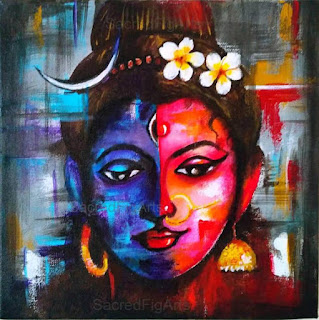






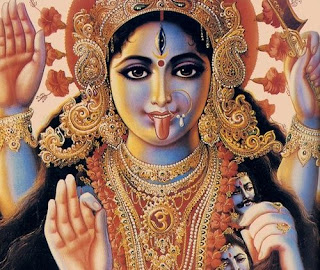










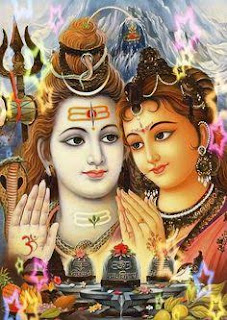




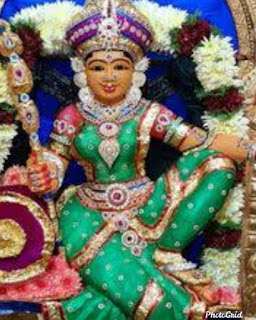
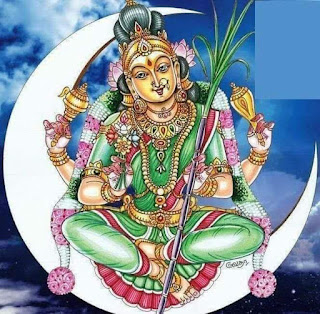






No comments:
Post a Comment